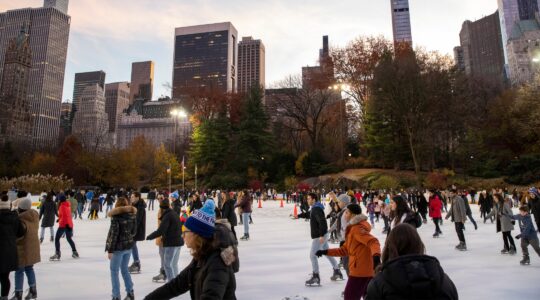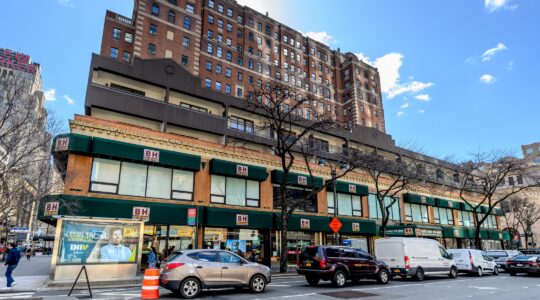Lately, it seems, everyone’s heading to Minneapolis. “I’ve got a day or two to kill,” they’ll say to me. “Any ideas about what to do?”
I can sum up my suggestions for the Minnesota city in one word: art. Modern, Jewish, classical, blockbusters as well as lesser-known gems, in first-class collections and architecturally striking buildings. There’s so much to look at (and I’m not even counting the famously attractive Jewish mayor, Jacob Frey, whose recent targeting by President Trump surely raised the city’s profile).
Perhaps best of all, considering the notoriously frigid climate, most (though not all) Minneapolis art is indoors. Several Jewish-themed exhibitions are currently on view, making a winter jaunt all the more appealing.
Mystical elements are familiar to fans of the painter Marc Chagall, but a new show at The Museum of Russian Art invites us to explore the influence of Jewish mystical tradition on Chagall and two of his Russian Empire-born peers. “Mystical Imprints: Marc Chagall, Ben-Zion, and Ben Shahn,” on view through March, showcases more than 70 prints, etchings and lithographs from these prominent 20th-century Jewish artists, including Chagall’s Bible series.
Fans of HBO’s hit series “Chernobyl” will enjoy another current show — the photography exhibition “After the Explosion: Documenting Chernobyl.” And the museum itself, singular in the U.S., is something of a destination. Its Spanish Colonial Revival building, like a piece of Texas in Minneapolis, was originally a Congregational Church, later a funeral home, and now serves as a repository for one of the largest collections anywhere of Russian and Soviet Realist art. (Visitors, take note: It’s also one of the few Minneapolis museums open on Mondays.)
Head downtown for the city’s marquee institutions. With its imposing columns, the Minneapolis Institute of Art (MIA) is a temple to the grand, old school museum tradition, housing nearly 100,000 pieces spanning epochs and continents in a Beaux-Arts landmark by McKim, Mead & White.
Art from around Asia is particularly well represented, along with classical sculpture and masterworks from European painters such as Goya, Matisse and Rembrandt. On view this winter is “The Sabbath Now,” a striking fiber sculpture that reimagines Shabbat ritual objects; many credit the Jewish artist, Norma Minkowitz, for elevating crochet to a fine art form.
Nearby is the Walker Art Center, Minneapolis’ home for modern and contemporary art — and a more substantive iteration than other homes for modern art. The Walker emphasizes connections between genres and disciplines, which is why Yoko Ono, Merce Cunningham and Meredith Monk are highlights alongside their museum-typical peers: Edward Hopper, Robert Rauschenberg, Claes Oldenburg.
From the collection of Minneapolis Jewish philanthropists comes a winter show that I hope not to miss. “The Expressionist Figure: The Miriam and Erwin Kelen Collection of Drawings,” opening in mid-November at the Walker, promises a dazzling survey of art on paper from the mid-20th century, with striking, often unsettling, works by Max Beckmann, Jasper Johns, Egon Schiele, Joan Miro, Rene Magritte and many more equally bold-faced names.
And all year long, wander into the Walker for unusual performance art or music from the likes of the Kronos Quartet.
Among the most unusual things you’ll see in Minneapolis, indoors or out, is the silver edifice shimmering on the University of Minnesota campus. It’s unmistakably a building by Frank Gehry, the Canadian-American Jewish starchitect, and despite its east-of-downtown location — by a highway overpass — it feels among Gehry’s most urbane.
This is the Weisman Art Museum, whose Jewish and establishment provenance belies the quirky assemblage within. Frederick Weisman was a Minneapolis native who became a Los Angeles entrepreneur and philanthropist; his eponymous L.A. foundation displays major American and European postwar artists, which he collected along with wife Marcia (who happened to be the sister of fabled Jewish art collector Norton Simon).
Weisman’s largesse gave his hometown university art museum a new name, as well as a fancy home for a decidedly idiosyncratic collection centered around three seemingly unrelated genres: traditional Korean furniture; pottery from the Mimbres, an ancient Native people of the American southwest; and American modernist painters, notably Marsden Hartley. Where the MIA strives to be comprehensive, the Weisman is the quite the opposite, offering unexpected sights around every Gehry-wavy corner.
If the weather is clear, I suggest continuing the aesthetic discoveries outdoors; Minneapolis has lately become a hotbed of mural art (a walking guide is available on Minneapolis.org). The skies might be gray, but in Minnesota’s art capital, there’s always plenty to look at.
The New York Jewish Week brings you the stories behind the headlines, keeping you connected to Jewish life in New York. Help sustain the reporting you trust by donating today.




